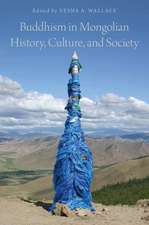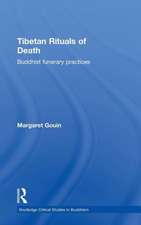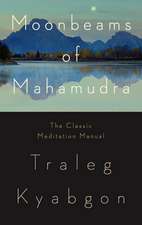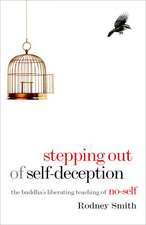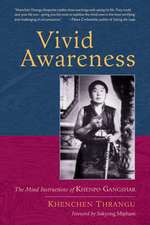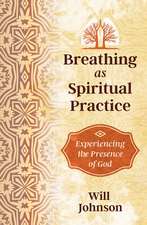Breathing through the Whole Body: The Buddha's Instructions on Integrating Mind, Body, and Breath
Autor Will Johnsonen Limba Engleză Paperback – 24 ian 2012
• Explains the complete series of steps in the Buddha’s Satipatthana Sutta for refining awareness of the breath, from posture and center of gravity to extending breath awareness beyond the nostrils, lungs, and abdomen to the entire body
• Shows that stillness in meditation refers only to the mind, not to the body
• Reveals breath to be a direct agent of healing for chronic tensions and an agitated mind
Explaining how stillness in meditation refers not to a rigid and frozen body but to a quality of mind, Will Johnson examines the Buddha’s own words at the core of the Satipatthana Sutta: “As you breathe in, breathe in through the whole body; as you breathe out, breathe out through the whole body”--an instruction often overlooked in the majority of Buddhist schools. Exploring the Buddha’s complete series of steps for deepening awareness of the breath, he shows how to invite natural, responsive movement back into the posture of meditation by extending breath awareness beyond the nostrils, lungs, and abdomen to the entire body--a practice that unifies the breath, body, and mind into a single shared phenomenon.
Showing how the flow of breath is directly affected by chronic tensions in the body and in the mind, Johnson explains that when breath starts flowing through more and more of the body, it becomes a direct agent of healing, massaging and melting any areas of tension it touches and moves through, whether physical or emotional. By breathing through the whole body in accordance with the Buddha’s instructions on breath, the body becomes much more comfortable, the mind starts resolving its addiction to thinking, and meditative practice deepens much more rapidly, allowing the teachings of the Buddha to be directly glimpsed and revealed.
Preț: 71.62 lei
Nou
Puncte Express: 107
Preț estimativ în valută:
13.71€ • 14.16$ • 11.41£
13.71€ • 14.16$ • 11.41£
Carte disponibilă
Livrare economică 04-18 martie
Livrare express 15-21 februarie pentru 13.74 lei
Preluare comenzi: 021 569.72.76
Specificații
ISBN-13: 9781594774348
ISBN-10: 159477434X
Pagini: 96
Dimensiuni: 137 x 210 x 8 mm
Greutate: 0.09 kg
Editura: Inner Traditions/Bear & Company
Colecția Inner Traditions
ISBN-10: 159477434X
Pagini: 96
Dimensiuni: 137 x 210 x 8 mm
Greutate: 0.09 kg
Editura: Inner Traditions/Bear & Company
Colecția Inner Traditions
Notă biografică
Will Johnson is the founder and director of the Institute for Embodiment Training, which combines Western somatic psychotherapy with Eastern meditation practices. He is the author of several books, including The Posture of Meditation and the award-winning The Spiritual Practices of Rumi. He lives in British Columbia.
Extras
Chapter 8
The Koan of Breathing
as you breathe in, breathe in through the whole body
as you breathe out, breathe out through the whole body
The Buddha often spoke in simple, pithy statements that are less like step-by-step instructions than they are like koans, or riddles, that we need to figure out for ourselves from the scantest of clues. In the Rinzai school of Zen Buddhism, meditators spend long hours focusing their mind on essentially alogical statements or stories called koans that make no sense whatsoever but are nonetheless presented as a kind of puzzle, to which the meditator has to come up with an answer or, at least, a response.*
*For example: Shuzan held out his short staff and said, “If you call this a short staff, you oppose its reality. If you do not call it a short staff, you ignore the fact. Now what do you wish to call this?”
The above quoted sentences from the Satipatthana Sutta are very much like a koan, except that you need to figure out this puzzle not with your mind but through the feeling awareness of your body.
Just as no one can provide you with the answer to a Zen koan, no one can show you definitively how to breathe through your whole body. You have to figure out on your own, by yourself, what you have to do (and mostly undo) and how you can best go about doing that. Breathing through your whole body is not in any way an expertise to attain or a skill set to perfect. It is not some far-off goal to achieve, but the possibility in the very breath you’re taking, a constant reminder simply to let go as best you can, to relax into your body, to yield to the primal impulse to breathe. From one stepping-stone of breath to the next, it leads you along a path whose only goal is to be as present as possible to the possibilities of the stepping-stone you’re on.
Focusing awareness on the breath at the front of the body is an instruction that’s relatively easy to understand and follow. So are the implications of the suggestion to observe whether the breath is long or short. But breathing through the whole body is an entirely different kind of instruction. It is more like the answer to the riddle of breath than the instructions on how to solve it.
Breathing through the whole body hints at a condition in which body, breath, and mind--ordinarily so disconnected from one another--can be felt to come together into a single, coterminous phenomenon. While you have to discover for yourself how the integration of these three aspects of experience might occur, the following principles, and the exercises that follow, can help guide you in your efforts.
For starters, the practice is not about making any efforts, but about letting go. You can’t artificially manufacture a breath that breathes through the whole body; nor would you want to. You can only surrender to the impulse to breathe and keep letting go, as best you can, of whatever tension and stillness you encounter in your body as you do. Letting go of whatever binds your body and contracts your mind is meditation’s constant opportunity (as well as its challenge). Exploring the possibility of breathing through your whole body, you have no choice but to keep letting go.
The Buddha tells us that, before we begin focusing on the activity of the breath, we want to make sure that the spine is erect and upright. Don’t, however, do yourself the disservice of believing there’s a goal of some kind of perfected condition of balance and upright alignment that you need to attain and then maintain. Your goal isn’t to mold your body into some idealized shape like pressing dough into a cookie cutter; your goal is simply to play with balance in the body you bring to the cushion, to feel how the sensations and energies in the body keep lightening up as the segments of the body keep lining up, one above the other. Playing with balance in meditation is always about remembering to let go into the next least effortful place.
Tensions in the body always function as a concealing blanket that covers over the felt life of the body’s sensations, so as you begin to relax and let go, dropping the weight of the body through the upright spine, the feeling presence of the body emerges more and more. The more of your body you feel, the more opportunities you have to let go through the breath. Breath can only breathe through a body in touch with itself.
Just as sensation is everywhere, so is movement everywhere. Motions of breath and presence of body are inextricably linked. You can’t have one without the other. A breath that breathes through the whole body will be a breath of constant, tidal motion.
Playing with balance, relaxing the body by surrendering its weight to gravity, opening to the possibility of feeling sensation in every cell of the body, letting go of tension in the body and contraction in the mind, opening to the subtle motions that want to occur in the body even as you sit silently on your cushion: these are the rules of thumb, the guiding principles that you want to keep circling back to over and over and over again as you explore the koan to breathe through the whole body. Each on its own implies or leads directly to the others. Explored in concert, they can have a powerfully catalyzing effect on the process of meditation.
Remember: breathing through the whole body is not some kind of calisthenic exercise; it is a koan to guide you as you sit down to meditate, a seed possibility that gradually takes root, grows, and matures over time.
The Koan of Breathing
as you breathe in, breathe in through the whole body
as you breathe out, breathe out through the whole body
The Buddha often spoke in simple, pithy statements that are less like step-by-step instructions than they are like koans, or riddles, that we need to figure out for ourselves from the scantest of clues. In the Rinzai school of Zen Buddhism, meditators spend long hours focusing their mind on essentially alogical statements or stories called koans that make no sense whatsoever but are nonetheless presented as a kind of puzzle, to which the meditator has to come up with an answer or, at least, a response.*
*For example: Shuzan held out his short staff and said, “If you call this a short staff, you oppose its reality. If you do not call it a short staff, you ignore the fact. Now what do you wish to call this?”
The above quoted sentences from the Satipatthana Sutta are very much like a koan, except that you need to figure out this puzzle not with your mind but through the feeling awareness of your body.
Just as no one can provide you with the answer to a Zen koan, no one can show you definitively how to breathe through your whole body. You have to figure out on your own, by yourself, what you have to do (and mostly undo) and how you can best go about doing that. Breathing through your whole body is not in any way an expertise to attain or a skill set to perfect. It is not some far-off goal to achieve, but the possibility in the very breath you’re taking, a constant reminder simply to let go as best you can, to relax into your body, to yield to the primal impulse to breathe. From one stepping-stone of breath to the next, it leads you along a path whose only goal is to be as present as possible to the possibilities of the stepping-stone you’re on.
Focusing awareness on the breath at the front of the body is an instruction that’s relatively easy to understand and follow. So are the implications of the suggestion to observe whether the breath is long or short. But breathing through the whole body is an entirely different kind of instruction. It is more like the answer to the riddle of breath than the instructions on how to solve it.
Breathing through the whole body hints at a condition in which body, breath, and mind--ordinarily so disconnected from one another--can be felt to come together into a single, coterminous phenomenon. While you have to discover for yourself how the integration of these three aspects of experience might occur, the following principles, and the exercises that follow, can help guide you in your efforts.
For starters, the practice is not about making any efforts, but about letting go. You can’t artificially manufacture a breath that breathes through the whole body; nor would you want to. You can only surrender to the impulse to breathe and keep letting go, as best you can, of whatever tension and stillness you encounter in your body as you do. Letting go of whatever binds your body and contracts your mind is meditation’s constant opportunity (as well as its challenge). Exploring the possibility of breathing through your whole body, you have no choice but to keep letting go.
The Buddha tells us that, before we begin focusing on the activity of the breath, we want to make sure that the spine is erect and upright. Don’t, however, do yourself the disservice of believing there’s a goal of some kind of perfected condition of balance and upright alignment that you need to attain and then maintain. Your goal isn’t to mold your body into some idealized shape like pressing dough into a cookie cutter; your goal is simply to play with balance in the body you bring to the cushion, to feel how the sensations and energies in the body keep lightening up as the segments of the body keep lining up, one above the other. Playing with balance in meditation is always about remembering to let go into the next least effortful place.
Tensions in the body always function as a concealing blanket that covers over the felt life of the body’s sensations, so as you begin to relax and let go, dropping the weight of the body through the upright spine, the feeling presence of the body emerges more and more. The more of your body you feel, the more opportunities you have to let go through the breath. Breath can only breathe through a body in touch with itself.
Just as sensation is everywhere, so is movement everywhere. Motions of breath and presence of body are inextricably linked. You can’t have one without the other. A breath that breathes through the whole body will be a breath of constant, tidal motion.
Playing with balance, relaxing the body by surrendering its weight to gravity, opening to the possibility of feeling sensation in every cell of the body, letting go of tension in the body and contraction in the mind, opening to the subtle motions that want to occur in the body even as you sit silently on your cushion: these are the rules of thumb, the guiding principles that you want to keep circling back to over and over and over again as you explore the koan to breathe through the whole body. Each on its own implies or leads directly to the others. Explored in concert, they can have a powerfully catalyzing effect on the process of meditation.
Remember: breathing through the whole body is not some kind of calisthenic exercise; it is a koan to guide you as you sit down to meditate, a seed possibility that gradually takes root, grows, and matures over time.
Cuprins
Introduction
Part One
The Foundation of the Body
1 A Quiet Place
2 The Upright Spine
3 Center of Gravity
4 Solidity and Vibration
5 Stillness and Motion
6 Letting Go
Part Two
The Breath of Unending Motion
7 Into the Center
8 The Koan of Breathing
Upright Spine
Upside Down Broom
The Moving Spine
Befriending Stillness
Feeling Presence
Drawing Down
The Breath of the Unfolding Fern
Rocking the Pelvis
Floating Shoulders, Sinking Hands
Breathing the Six Directions
9 Calming the Body
10 Turning the Wheel
About the Author
Index
Part One
The Foundation of the Body
1 A Quiet Place
2 The Upright Spine
3 Center of Gravity
4 Solidity and Vibration
5 Stillness and Motion
6 Letting Go
Part Two
The Breath of Unending Motion
7 Into the Center
8 The Koan of Breathing
Upright Spine
Upside Down Broom
The Moving Spine
Befriending Stillness
Feeling Presence
Drawing Down
The Breath of the Unfolding Fern
Rocking the Pelvis
Floating Shoulders, Sinking Hands
Breathing the Six Directions
9 Calming the Body
10 Turning the Wheel
About the Author
Index
Recenzii
“With simplicity and elegance, Will Johnson returns us to the original teachings of the Buddha on embodied spirituality, taking us deeper by teaching us a fuller and more subtle engagement with body and breath, leading directly to the expanse of liberation. This book will be treasured as a brilliant revelation of the spiritual possibilities of our own human mind.”
“I love every word! Thank you so much for bringing forth such a succinct and glowingly accurate account of the central role that body wisdom, somatic experiencing, plays in the process of awakening. It is a ‘how to do it’ book for all of us on this road to realizing our true nature.”
“Breathing Through the Whole Body is a beautiful book, somewhat meditative in and of itself. It examines each part of the deepening, explaining things like why our spine needs to be straight and why we focus on the breath. The overall purpose isn’t to look good but to find that inner quietness and rooted balance that will ultimately bring forth whole body breathing.”
“The book is written lovingly, offering compassionate explanations and poetically rendered practice exercises (Befriending Stillness, Drawing Down, The Breath of the Unfolding Fern). Very little effort is required to retrieve the gift that lies within its pages. It is a unique treasure.”
“Will Johnson encourages readers to put together their whole spirit and gain a more complete control over their mind, emotions, and body. With exercises both physical, mental, and spiritual, Breathing Through the Whole Body is a strongly recommended pick for spirituality and Buddhist studies collections.”
“The most profound healing gift of all is found within our very breath. Learn how the flow of breath is directly affected by chronic tensions in the body and in the mind. When breath starts flowing through more of the body, it becomes a direct agent of healing massaging and melting any areas of tension it touches. Experience the healing technique as taught 2500 years ago by the Buddha!”
“I love every word! Thank you so much for bringing forth such a succinct and glowingly accurate account of the central role that body wisdom, somatic experiencing, plays in the process of awakening. It is a ‘how to do it’ book for all of us on this road to realizing our true nature.”
“Breathing Through the Whole Body is a beautiful book, somewhat meditative in and of itself. It examines each part of the deepening, explaining things like why our spine needs to be straight and why we focus on the breath. The overall purpose isn’t to look good but to find that inner quietness and rooted balance that will ultimately bring forth whole body breathing.”
“The book is written lovingly, offering compassionate explanations and poetically rendered practice exercises (Befriending Stillness, Drawing Down, The Breath of the Unfolding Fern). Very little effort is required to retrieve the gift that lies within its pages. It is a unique treasure.”
“Will Johnson encourages readers to put together their whole spirit and gain a more complete control over their mind, emotions, and body. With exercises both physical, mental, and spiritual, Breathing Through the Whole Body is a strongly recommended pick for spirituality and Buddhist studies collections.”
“The most profound healing gift of all is found within our very breath. Learn how the flow of breath is directly affected by chronic tensions in the body and in the mind. When breath starts flowing through more of the body, it becomes a direct agent of healing massaging and melting any areas of tension it touches. Experience the healing technique as taught 2500 years ago by the Buddha!”
Descriere
Explores the Buddha’s own words on breathing meditation for healing, wholeness, and a deeper understanding of his teachings.

